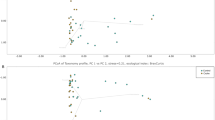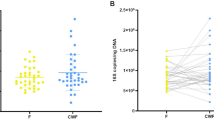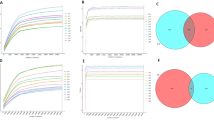Abstract
The stomach acts as a barrier to ingested microbes, thereby influencing the microbial ecology of the entire gastrointestinal (GI) tract. The stomach microbiota and the role of human host and environmental factors, such as health status or medications, in shaping its composition remain largely unknown. We sought to characterize the bacterial and fungal microbiota in the stomach fluid in order to gain insights into the role of the stomach in GI homeostasis. Gastric fluid was collected from 25 patients undergoing clinically indicated upper endoscopy. DNA isolates were used for PCR amplification of bacterial 16S ribosomal RNA (rRNA) genes and fungal internal transcribed spacers (ITS). RNA isolates were used for 16S rRNA cDNA generation and subsequent PCR amplification. While all stomach fluid samples are dominated by the phyla Firmicutes, Bacteroidetes, Actinobacteria, Proteobacteria and Fusobacteria (>99% of sequence reads), the transcriptionally active microbiota shows significant reduction in Actinobacteria (34%) and increase in Campylobacter (444%) (P<0.003), specifically the oral commensal and suspected intestinal pathogen Campylobacter concisus. Bacterial but not fungal diversity is reduced by antibiotic treatment (28%; P<0.02), immunosuppression in transplant recipients and HIV/AIDS patients (42%; P<0.001) and gastric fluid pH >4 (70%; P<0.05). Immunosuppression correlates with decreased abundance of Prevotella (24%), Fusobacterium (2%) and Leptotrichia (6%) and increased abundance of Lactobacillus (3844%) (P<0.003). We have generated the first in-depth characterization of the human gastric fluid microbiota, using bacterial 16S rRNA gene and transcript, and fungal ITS amplicon sequencing and provide evidence for a significant impact of the host immune status on its composition with likely consequences for human health.
Similar content being viewed by others
Log in or create a free account to read this content
Gain free access to this article, as well as selected content from this journal and more on nature.com
or
References
Aabenhus R, Permin H, On SL, Andersen LP . (2002). Prevalence of Campylobacter concisus in diarrhoea of immunocompromised patients. Scand J Infect Dis 34: 248–252.
Amieva MR, El-Omar EM . (2008). Host-bacterial interactions in Helicobacter pylori infection. Gastroenterology 134: 306–323.
Andersson AF, Lindberg M, Jakobsson H, Backhed F, Nyren P, Engstrand L . (2008). Comparative analysis of human gut microbiota by barcoded pyrosequencing. PLoS One 3: e2836.
Angiuoli SV, Matalka M, Gussman A, Galens K, Vangala M, Riley DR et al (2011). CloVR: a virtual machine for automated and portable sequence analysis from the desktop using cloud computing. BMC Bioinformatics 12: 356.
Batty I . (1958). Actinomyces odontolyticus, a new species of actinomycete regularly isolated from deep carious dentine. J Pathol Bacteriol 75: 455–459.
Bik EM, Eckburg PB, Gill SR, Nelson KE, Purdom EA, Francois F et al (2006). Molecular analysis of the bacterial microbiota in the human stomach. Proc Natl Acad Sci USA 103: 732–737.
Borneman J, Hartin RJ . (2000). PCR primers that amplify fungal rRNA genes from environmental samples. Appl Environ Microbiol 66: 4356–4360.
Brown JM, Georg LK, Waters LC . (1969). Laboratory identification of Rothia dentocariosa and its occurrence in human clinical materials. Appl Microbiol 17: 150–156.
Caporaso JG, Kuczynski J, Stombaugh J, Bittinger K, Bushman FD, Costello EK et al (2010). QIIME allows analysis of high-throughput community sequencing data. Nat Methods 7: 335–336.
Costello EK, Lauber CL, Hamady M, Fierer N, Gordon JI, Knight R . (2009). Bacterial community variation in human body habitats across space and time. Science 326: 1694–1697.
Crielaard W, Zaura E, Schuller AA, Huse SM, Montijn RC, Keijser BJ . (2011). Exploring the oral microbiota of children at various developmental stages of their dentition in the relation to their oral health. BMC Med Genomics 4: 22.
Croswell A, Amir E, Teggatz P, Barman M, Salzman NH . (2009). Prolonged impact of antibiotics on intestinal microbial ecology and susceptibility to enteric Salmonella infection. Infect Immun 77: 2741–2753.
DeSantis TZ, Hugenholtz P, Keller K, Brodie EL, Larsen N, Piceno YM et al (2006). NAST: a multiple sequence alignment server for comparative analysis of 16S rRNA genes. Nucleic Acids Res 34: W394–W399.
Dicksved J, Lindberg M, Rosenquist M, Enroth H, Jansson JK, Engstrand L . (2009). Molecular characterization of the stomach microbiota in patients with gastric cancer and in controls. J Med Microbiol 58: 509–516.
Edgar RC . (2004). MUSCLE: multiple sequence alignment with high accuracy and high throughput. Nucleic Acids Res 32: 1792–1797.
Edgar RC . (2010). Search and clustering orders of magnitude faster than BLAST. Bioinformatics 26: 2460–2461.
Endt K, Stecher B, Chaffron S, Slack E, Tchitchek N, Benecke A et al (2010). The microbiota mediates pathogen clearance from the gut lumen after non-typhoidal Salmonella diarrhea. PLoS Pathog 6: e1001097.
Gardner JD, Ciociola AA, Robinson M . (2002). Measurement of meal-stimulated gastric acid secretion by in vivo gastric autotitration. J Appl Physiol 92: 427–434.
Ghannoum MA, Jurevic RJ, Mukherjee PK, Cui F, Sikaroodi M, Naqvi A et al (2010). Characterization of the oral fungal microbiome (mycobiome) in healthy individuals. PLoS Pathog 6: e1000713.
Guadalupe M, Reay E, Sankaran S, Prindiville T, Flamm J, McNeil A et al (2003). Severe CD4+ T-cell depletion in gut lymphoid tissue during primary human immunodeficiency virus type 1 infection and substantial delay in restoration following highly active antiretroviral therapy. J Virol 77: 11708–11717.
Hess DL, Pettersson AM, Rijnsburger MC, Herbrink P, van den Berg HP, Ang CW . (2012). Gastro-enteritis caused by Campylobacter concisus: case report and short review of literature. J Med Microbiol 61: (Pt 5) 746–749.
Horwitch CA, Furseth HA, Larson AM, Jones TL, Olliffe JF, Spach DH . (1995). Lactobacillemia in three patients with AIDS. Clin Infect Dis 21: 1460–1462.
Howden CW, Hunt RH . (1987). Relationship between gastric secretion and infection. Gut 28: 96–107.
Jenq RR, Ubeda C, Taur Y, Menezes CC, Khanin R, Dudakov JA et al (2012). Regulation of intestinal inflammation by microbiota following allogeneic bone marrow transplantation. J Exp Med 209: 903–911.
Lauber CL, Zhou N, Gordon JI, Knight R, Fierer N . (2010). Effect of storage conditions on the assessment of bacterial community structure in soil and human-associated samples. FEMS Microbiol Lett 307: 80–86.
Leonard J, Marshall JK, Moayyedi P . (2007). Systematic review of the risk of enteric infection in patients taking acid suppression. Am J Gastroenterol 102: 2047–2056 quiz 2057.
Lu JJ, Perng CL, Shyu RY, Chen CH, Lou Q, Chong SK et al (1999). Comparison of five PCR methods for detection of Helicobacter pylori DNA in gastric tissues. J Clin Microbiol 37: 772–774.
Maldonado-Contreras A, Goldfarb KC, Godoy-Vitorino F, Karaoz U, Contreras M, Blaser MJ et al (2011). Structure of the human gastric bacterial community in relation to Helicobacter pylori status. ISME J 5: 574–579.
Man SM, Zhang L, Day AS, Leach ST, Lemberg DA, Mitchell H . (2010). Campylobacter concisus and other Campylobacter species in children with newly diagnosed Crohn’s disease. Inflamm Bowel Dis 16: 1008–1016.
Martinsen TC, Bergh K, Waldum HL . (2005). Gastric juice: a barrier against infectious diseases. Basic Clin Pharmacol Toxicol 96: 94–102.
Maukonen J, Simoes C, Saarela M . (2012). The currently used commercial DNA-extraction methods give different results of clostridial and actinobacterial populations derived from human fecal samples. FEMS Microbiol Ecol 79: 697–708.
Nannini EC, Okhuysen PC . (2002). HIV1 and the gut in the era of highly active antiretroviral therapy. Curr Gastroenterol Rep 4: 392–398.
Papadimitriou JC, Cangro CB, Lustberg A, Khaled A, Nogueira J, Wiland A et al (2003). Histologic features of mycophenolate mofetil-related colitis: a graft-versus-host disease-like pattern. Int J Surg Pathol 11: 295–302.
Patel R, Cockerill FR, Porayko MK, Osmon DR, Ilstrup DM, Keating MR . (1994). Lactobacillemia in liver transplant patients. Clin Infect Dis 18: 207–212.
Pei Z, Bini EJ, Yang L, Zhou M, Francois F, Blaser MJ . (2004). Bacterial biota in the human distal esophagus. Proc Natl Acad Sci USA 101: 4250–4255.
Peris-Bondia F, Latorre A, Artacho A, Moya A, D’Auria G . (2011). The active human gut microbiota differs from the total microbiota. PLoS One 6: e22448.
Price MN, Dehal PS, Arkin AP . (2010). FastTree 2—approximately maximum-likelihood trees for large alignments. PLoS One 5: e9490.
Ravel J, Gajer P, Abdo Z, Schneider GM, Koenig SS, McCulle SL et al (2011). Vaginal microbiome of reproductive-age women. Proc Natl Acad Sci USA 108 (Suppl 1): 4680–4687.
Sanduleanu S, Jonkers D, De Bruine A, Hameeteman W, Stockbrugger RW . (2001). Non-Helicobacter pylori bacterial flora during acid-suppressive therapy: differential findings in gastric juice and gastric mucosa. Aliment Pharmacol Ther 15: 379–388.
Schloss PD, Westcott SL, Ryabin T, Hall JR, Hartmann M, Hollister EB et al (2009). Introducing mothur: open-source, platform-independent, community-supported software for describing and comparing microbial communities. Appl Environ Microbiol 75: 7537–7541.
Smit E, Leeflang P, Glandorf B, van Elsas JD, Wernars K . (1999). Analysis of fungal diversity in the wheat rhizosphere by sequencing of cloned PCR-amplified genes encoding 18S rRNA and temperature gradient gel electrophoresis. Appl Environ Microbiol 65: 2614–2621.
Tennant SM, Hartland EL, Phumoonna T, Lyras D, Rood JI, Robins-Browne RM et al (2008). Influence of gastric acid on susceptibility to infection with ingested bacterial pathogens. Infect Immun 76: 639–645.
Thom K, Forrest G . (2006). Gastrointestinal infections in immunocompromised hosts. Curr Opin Gastroenterol 22: 18–23.
Van Etterijck R, Breynaert J, Revets H, Devreker T, Vandenplas Y, Vandamme P et al (1996). Isolation of Campylobacter concisus from feces of children with and without diarrhea. J Clin Microbiol 34: 2304–2306.
Villarroel MC, Hidalgo M, Jimeno A . (2009). Mycophenolate mofetil: An update. Drugs Today (Barc) 45: 521–532.
Vorobjova T, Watanabe T, Chiba T . (2008). Helicobacter pylori immunology and vaccines. Helicobacter 13 (Suppl 1): 18–22.
Wang Q, Garrity GM, Tiedje JM, Cole JR . (2007). Naive Bayesian classifier for rapid assignment of rRNA sequences into the new bacterial taxonomy. Appl Environ Microbiol 73: 5261–5267.
White JR, Arze C, Matalka M, Team TC, White O, Angiuoli SV et al (2011). CloVR-16S: Phylogenetic microbial community composition analysis based on 16S ribosomal RNA amplicon sequencing—standard operating procedure, version 1.1. Nature Preced doi:10.1038/npre.2011.6287.2.
White JR, Maddox C, White O, Angiuoli SV, Fricke WF . (2013). CloVR-ITS: automated internal transcribed spacer amplicon sequence analysis pipeline for the characterization of fungal microbiota. Microbiome 1: 6.
White JR, Nagarajan N, Pop M . (2009). Statistical methods for detecting differentially abundant features in clinical metagenomic samples. PLoS Comput Biol 5: e1000352.
Wu GD, Lewis JD, Hoffmann C, Chen YY, Knight R, Bittinger K et al (2010). Sampling and pyrosequencing methods for characterizing bacterial communities in the human gut using 16S sequence tags. BMC Microbiol 10: 206.
Zaura E, Keijser BJ, Huse SM, Crielaard W . (2009). Defining the healthy ‘core microbiome’ of oral microbial communities. BMC Microbiol 9: 259.
Zen M, Canova M, Campana C, Bettio S, Nalotto L, Rampudda M et al (2011). The kaleidoscope of glucorticoid effects on immune system. Autoimmun Rev 10: 305–310.
Zoetendal EG, Akkermans AD, De Vos WM . (1998). Temperature gradient gel electrophoresis analysis of 16S rRNA from human fecal samples reveals stable and host-specific communities of active bacteria. Appl Environ Microbiol 64: 3854–3859.
Acknowledgements
Funding for this study was provided by the National Human Genome Research Institute (NHGRI) and the Institute of Diabetes, Digestive and Kidney Diseases (NIDDK) from the National Institutes of Health (NIH) (RC2 HG005597 and R01 DK046461).
Author information
Authors and Affiliations
Corresponding author
Additional information
Supplementary Information accompanies this paper on The ISME Journal website
Rights and permissions
About this article
Cite this article
von Rosenvinge, E., Song, Y., White, J. et al. Immune status, antibiotic medication and pH are associated with changes in the stomach fluid microbiota. ISME J 7, 1354–1366 (2013). https://doi.org/10.1038/ismej.2013.33
Received:
Revised:
Accepted:
Published:
Issue date:
DOI: https://doi.org/10.1038/ismej.2013.33
Keywords
This article is cited by
-
Analysis of bacterial diversity and community structure in gastric juice of patients with advanced gastric cancer
Discover Oncology (2023)
-
Species composition and overall diversity are significantly correlated between the tongue coating and gastric fluid microbiomes in gastritis patients
BMC Medical Genomics (2022)
-
Nonlinear machine learning pattern recognition and bacteria-metabolite multilayer network analysis of perturbed gastric microbiome
Nature Communications (2021)
-
Propionibacterium acnes overabundance in gastric cancer promote M2 polarization of macrophages via a TLR4/PI3K/Akt signaling
Gastric Cancer (2021)
-
Gastric cancer: genome damaged by bugs
Oncogene (2020)



